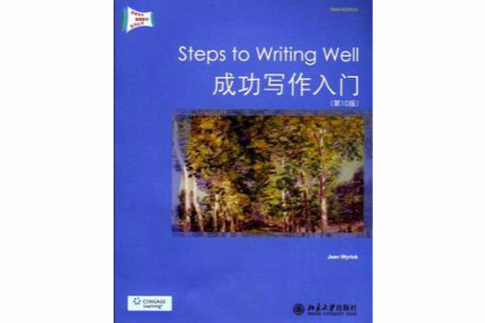《成功寫作入門》是2008年北京大學出版社出版的圖書,作者是吉恩·埃里克。本書主要通過舉例說明來逐步闡述寫作的概念,闡明了寫作過程直至寫作成功完成,幫助學生將課堂上學習到的內容運用到實踐中。
基本介紹
- 作者:吉恩·埃里克
- ISBN:9787301142509
- 頁數:594
- 定價:65.00元
- 出版社:北京大學出版社
- 出版時間:2008-9
- 裝幀:平裝
- 原作名:Steps to Writing Well
- 叢書: 英語寫作原版影印系列叢書
內容介紹,作者介紹,作品目錄,
內容介紹
《成功寫作入門(第10版)》是一本逐步指導寫作的書,實用性、指導性非常強。書的內容設計合理,講解深入淺出,通過舉例說明來逐步闡述寫作的概念,闡明了寫作過程直至寫作成功完成。書中配有習題及課後寫作,幫助學生將課堂上學習到的內容運用到實踐中,學以致用。書中引用了40多幅引人思考的圖片、照片、廣告,來啟迪學生寫作思維,並且新增加了第17章關於視覺藝術的寫作;書中還引用了17篇學生作文和20多篇專業的例子,提供寫作參考、題目建議,增加了寫作體裁選擇的可能性的模式。
作者介紹
Jean Wynck,是美國科羅拉多州立大學(Colorado State University)的榮譽退休教授(Professor Emerita),曾任該校寫作教研部主任11年之久。她有豐富的教學經驗,在近30年的教學生涯中,主講過本科英語寫作課、培訓過英語寫作教師並擔任多項寫作研究項目的負責人。此外,她還著有“The Rinehart Reader”和“Discovering Ideas”等著作。她曾發表了二十多篇關於寫作和美國文學方面的論文。目前她研究的主要內容包括19世紀晚期和20世紀初的美國小說、美國研究以及婦女研究。她出版的三本大學寫作教材都曾多次再版。
作品目錄
Part One The Basics of the Short Essay
1 Prewriting
Getting Started (or Soup-Can Labels Can Be Fascinating)
Selecting a Subject
Finding Your Essay's Purpose and Focus
Pump-Primer Techniques
After You've Found Your Focus
Practicing What You’ve Learned
Discovering Your Audience
How to Identify Your Readers
Practicing What You've Learned
Assignment
Keeping a Journal (Talking to Yourself Does Help)
Chapter 1 Summary
2 The Thesis Statement
What Is a Thesis? What Does a "Working Thesis" Do?
Can a "Working Thesis" Change?
Guidelines for Writing a Good Thesis
Avoiding Common Errors in Thesis Statements
Practicing What You've Learned
Assignment
Using the Essay Map
Practicing What You've Learned
Assignment
Chapter 2 Summary
3e Topic Sentence 50
Focusing Your Topic Sentence
Placing Your Topic Sentence
Practicing What You've Learned
Assignment
Applying What You've Learned to Your Writing
Paragraph Development
Paragraph Length
Practicing What You've Learned
Assignment
Applying What You've Learned to Your Writing
Paragraph Unity
Practicing What You've Learned
Applying What You've Learned to Your Writing
Paragraph Coherence
Practicing What You're Learned
Paragraph Sequence
Transitions between Paragraphs
Applying What You've Learned to Your Writing
Chapter 3 Summary
4 Beginnings and Endings
How to Write a Good Lead-in
Avoiding Errors in Lead-ins
Practicing What You've learned
Assignment
How to Write a Good Concluding Paragraph
Avoiding Errors in Conclusions
Practicing What You're Learned
Assignment
How to Write a Good Title
Practicing What You've learned
Assignment
Applying What You've Learned to Your Writing
Chapter 4 Summary
5 Drafting and Revising: Creative Thinking, Critical Thinking
What Is Revision?
When Does Revision Occur?
Myths about Revision
Can I Learn to Improve My Revision Skills?
Preparing to Draft some Time-Saving Hints
Additional Suggestions for Writers with Word Processors
Writing Centers, Computer Labs, and Computer Classrooms
A Revision Process for Your Drafts
I. Revising for Purpose, Thesis, and Audience
II. Revising for Ideas and Evidence
Ⅲ. Revising for Organization
IV. Revising for Clarity and Style
V. Editing for Errors
VI. Proofreading
A Final Checklist for Your Essay
Practicing What You've Learned
Benefiting from Revision Workshops
Practicing You're Learned
Assignment
Some Last Advice: How to Play with Your Mental Blocks
Chapter 5 Summary
6 Effective Sentences
7 Word Logic
8 The Reading-Writing Connection
Part Two Purposes, Modes, and Strategies
9 Exposition
10 Argumentation
11 Description
12 Narration
13 Writing Essays Using Multiple Strategies
Part Three Special Assignments
14 Writing a Paper Using Research
15 Writing in Class: Exams and "Response" Essays
16 Writing about Literature
17 Writing about Visual Arts
18 Writing about Film
19 Writing in the World of Work
Part Four A Concise Handbook
20 Major Errors in Grammar
21 A Concise Guide to Punctuation
22 A Concise Guide to Mechanics
List of Artworks
List of Advertisements
1 Prewriting
Getting Started (or Soup-Can Labels Can Be Fascinating)
Selecting a Subject
Finding Your Essay's Purpose and Focus
Pump-Primer Techniques
After You've Found Your Focus
Practicing What You’ve Learned
Discovering Your Audience
How to Identify Your Readers
Practicing What You've Learned
Assignment
Keeping a Journal (Talking to Yourself Does Help)
Chapter 1 Summary
2 The Thesis Statement
What Is a Thesis? What Does a "Working Thesis" Do?
Can a "Working Thesis" Change?
Guidelines for Writing a Good Thesis
Avoiding Common Errors in Thesis Statements
Practicing What You've Learned
Assignment
Using the Essay Map
Practicing What You've Learned
Assignment
Chapter 2 Summary
3e Topic Sentence 50
Focusing Your Topic Sentence
Placing Your Topic Sentence
Practicing What You've Learned
Assignment
Applying What You've Learned to Your Writing
Paragraph Development
Paragraph Length
Practicing What You've Learned
Assignment
Applying What You've Learned to Your Writing
Paragraph Unity
Practicing What You've Learned
Applying What You've Learned to Your Writing
Paragraph Coherence
Practicing What You're Learned
Paragraph Sequence
Transitions between Paragraphs
Applying What You've Learned to Your Writing
Chapter 3 Summary
4 Beginnings and Endings
How to Write a Good Lead-in
Avoiding Errors in Lead-ins
Practicing What You've learned
Assignment
How to Write a Good Concluding Paragraph
Avoiding Errors in Conclusions
Practicing What You're Learned
Assignment
How to Write a Good Title
Practicing What You've learned
Assignment
Applying What You've Learned to Your Writing
Chapter 4 Summary
5 Drafting and Revising: Creative Thinking, Critical Thinking
What Is Revision?
When Does Revision Occur?
Myths about Revision
Can I Learn to Improve My Revision Skills?
Preparing to Draft some Time-Saving Hints
Additional Suggestions for Writers with Word Processors
Writing Centers, Computer Labs, and Computer Classrooms
A Revision Process for Your Drafts
I. Revising for Purpose, Thesis, and Audience
II. Revising for Ideas and Evidence
Ⅲ. Revising for Organization
IV. Revising for Clarity and Style
V. Editing for Errors
VI. Proofreading
A Final Checklist for Your Essay
Practicing What You've Learned
Benefiting from Revision Workshops
Practicing You're Learned
Assignment
Some Last Advice: How to Play with Your Mental Blocks
Chapter 5 Summary
6 Effective Sentences
7 Word Logic
8 The Reading-Writing Connection
Part Two Purposes, Modes, and Strategies
9 Exposition
10 Argumentation
11 Description
12 Narration
13 Writing Essays Using Multiple Strategies
Part Three Special Assignments
14 Writing a Paper Using Research
15 Writing in Class: Exams and "Response" Essays
16 Writing about Literature
17 Writing about Visual Arts
18 Writing about Film
19 Writing in the World of Work
Part Four A Concise Handbook
20 Major Errors in Grammar
21 A Concise Guide to Punctuation
22 A Concise Guide to Mechanics
List of Artworks
List of Advertisements

